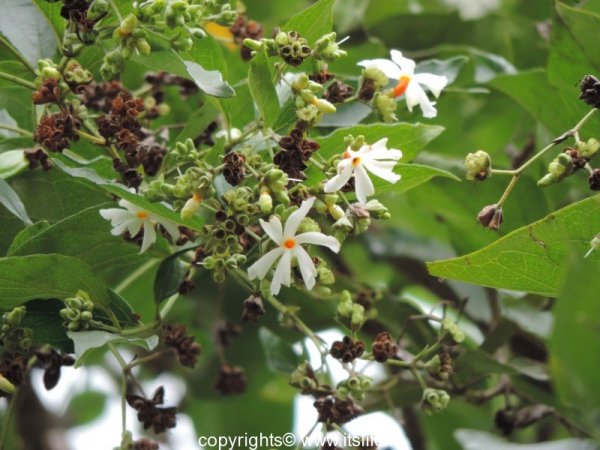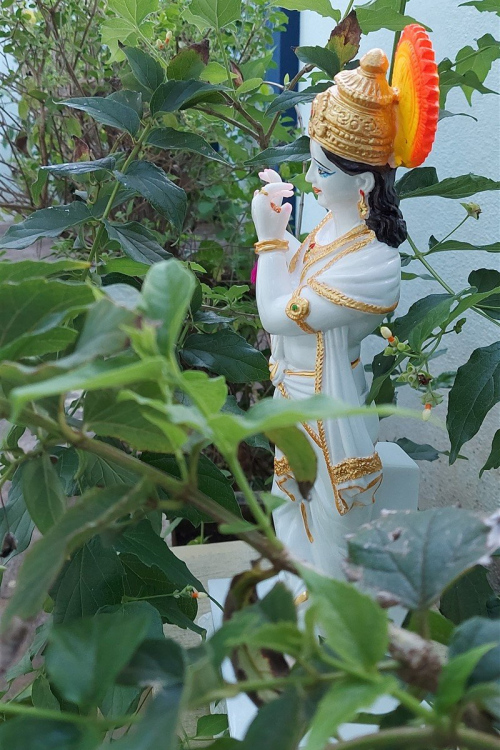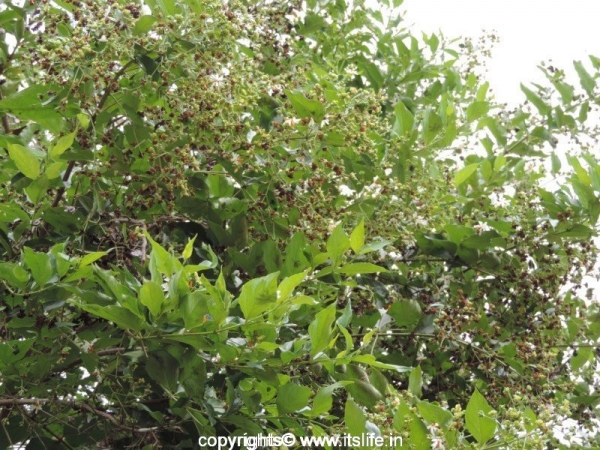I always dreamt of a garden space where a marble Gopala Krishna idol is installed below a Parijata tree. By dawn, the idol would be worshipped automatically by the falling fragrant Parijata.
Other English common names of Parijata Tree are Coral Jasmine, Tree of Sorrow, and Queen of the night. Har Singar in Hindi, Pavizhamalli in Tamil, Paarijat in Sanskrit, Malayalam, Marathi, and Kannada. Botanical name is Nyctanthes arbor-tristis and belongs to Oleaceae family.
Parijata Tree is native of South Asia and Southeast Asia and grows to a height of 10 to 12 meters. Parijata is the official State flower of West Bengal.
Bark is grey and flaky and leaves are green, rough, and hairy. Leaves are 6 to 12 cm long and 2 to 6.4 cm wide. The flowers have a bright orange tube in center with 5 to 8 white petals. They bloom in clusters and open at dusk and fall by dawn.
Mild fragrance of the flowers encompasses the tree surrounding.
The fruit is heart-shaped and flat. Green when young and turns to brown as they mature. The seeds contain one seed.
Legend associated with this tree:
In the Bhagavatha it is stated that Lord Krishna and Sathyabhama had gone to heaven and Sathyabhama loved the Parijatha tree in the garden. She asked Krishna if she could take the tree back to earth. Lord Krishna plucked the tree along with roots to take it back to earth. Lord Indra, the king of heaven was infuriated and fought with Lord Krishna. Indra lost the battle and begged Lord Krishna to let go of the Parijatha tree, as it was the most loved tree in heaven. Lord Krishna and Sathyabhama gave back the tree and returned back to earth a bit disappointed.
Other stories romanticizing the tree are narrated and one of them is that Lord Krishna bought the Parijata Tree from Lord Indra’s palace. He gave the plant to his wife Rukmini, due to which his other wife Satyabhama got jealous. To pacify Satyabhama, Krishna planted the tree inside Satyabhama’s courtyard. The tree grew in a slanting position and the flowers fell inside Rukmini’s courtyard. Satyabhama was annoyed about this and cursed that the tree would bloom only in the night and that the flowers should fade quickly.
Medicinal Use:
All parts of the plant are used in Ayurveda and Homoeopathy medicine to treat arthritis, fever, constipation, edema, cough, dandruff, and intestinal worms.
Other uses:
Dried Parijata flowers are used in Assamese cuisine. The flowers are in high demand in the perfume and aroma oil industry.
The flowers are offered to Lord Ganesha during 21 pushpa pooja while chanting the below verse: “Om Poothaya Namah Parijatak Pushpam Samarpami”.
Propagation:
The tree can be grown by seeds or by cuttings. Plant in well-drained soil and fertilize once a month.




